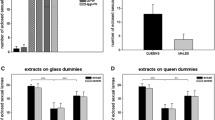Summary
The European slave-making antHarpagoxenus sublaevis has an unusual female polymorphism. In addition to ordinary workers, there are two kinds of reproductive females, the very rare full queens and the much more common ergatoid (i. e. workerlike) queens. A genetic mechanism is responsible for the development of larvae into either ergatoid or full queens.
Sixty-one colonies of the closely related North American speciesHarpagotenus canadensis were collected from several localities in the provinces of Ontario and Quebec, Canada, and a total of 241 workers, 30 intermorphs, and 26 dealate full queens were dissected in order to discover whether a similar polymorphism occurs in this species. However,H. canadensis was found to have an essentialy normal polymorphism. All the fecundated reproductive females that we found were dealate full queens. A spermatheca, which constitutes the only significant difference between ergatoid queens and workers inH. sublaevis, is absent in all workers and intermorphs ofH. canadensis.
In addition, we found that colonies ofH. canadensis are monogynous (likeH. sublaevis). However, minority of workers and intermorphs lay eggs even in queenright colonies. The average number of ovarioles is much lower inH. canadansis workers than in those ofH. sublaevis; but, in both species, it varies over about the same range (table IV). In this respect,H. canadensis workers resemble more closely the workers of the host species. The number of Malpighian tubules is five in both the reproductive females and workers. The poison gland is about the same size in bothHarpagoxenus species, but the Dufour's gland inH. canadensis is considerably smaller than inH. sublaevis. Thus, in several respects,H. canadensis bears a closer resemblance to the common host genusLeptothorax (subgenusMychothorax) thanH. sublaevis does.
Zusammenfassung
Die europäische, sklavenhaltende AmeiseHarpagoxenus sublaevis weist einen speziellen Polymorphismus im weiblichen Geschlecht auf: Neben normalen Arbeiterinnen kommen zwei Formen von Königinnen vor, das normale, jedoch sehr seltene, geflügelte Weibchen und das viel häufigere arbeiterinähnliche, sogenannte ergatoide Weibchen. Für die Entwicklung von Larven entweder zu ergatoiden oder zu geflügelten Weibchen ist ein genetischer Mechanismus verantwortlich.
Wir sammelten 61 Völker des nahe verwandten, nordamerikanischenHarpagoxenus canadensis an verschiedenen Orten in Ontario und Quebec, Kanada, und sezierten daraus insgesamt 241 Arbeiterinnen, 30 Intermorphe und 26 entflügelte Weibchen um festzustellen, ob ein ähnlicher Polymorphismus auch bei dieser Art vorliegt.H. canadensis hat jedoch einen recht normalen Polymorphismus. Alle Königinnen, die wir fanden, waren entflügelte Weibchen. Das receptaculum seminis, das den einzig bedeutsamen Unterschied zwischen ergatoiden Weibchen und Arbeiterinnen vonH. sublaevis darstellt, fehlt allen Arbeiterinnen und Intermorphen vonH. canadensis.
Weitere Ergebnisse unserer Untersuchung sind folgende:H. canadensis ist, wieH. sublaevis, monogyn. In wenigen Kolonien legen einige Arbeiterinnen und Intermorphe Eier, auch in weiserlrichtigen Völkern. Die durchschnittliche Ovariolenzahl ist beiH. canadensis-Arbeiterinnen wesentlich geringer als beiH. sublaevis, variiert bei beiden Arten jedoch in etwa demselben Ausmß (table IV);H. canadensis-Arbeiterinnen sind darin den Arbeiterinnen der Wirtsarten ähnlicher. Die Anzahl der Malpighigefäße beträgt 5 bei Weibchen und Arbeiterinnen. Die Giftdrüse hat bei beidenHarpagoxenus-Arten etwa dieselbe Größe. Dagegen ist beiH. canadensis die Dufour-Drüse erheblich kleiner als beiH. sublaevis. H. canadensis ist damit in einer Reihe von Merkmalen der gemeinsamen WirtsgattungLeptothorax (S. G.Mychothorax) ähnlicher alsH. sublaevis.
Similar content being viewed by others

Literature Cited
Adlerz (G.), 1896. — Myrmecologiska studier. III. Tomognathus sublaevis Mayr.bihang till K. Svenska Vet. Akad. Handl., 21, 1–76.
Buschinger (A.), 1975. — Eine genetische Komponente im Polymorphismus der dulotischen Ameise Harpagoxenus sublaevis.Naturwissenschaften, 62, 239.—Buschinger (A.), 1978. Genetisch bedingte Entstehung geflügelter Weibchen bei der sklavenhaltenden Ameise Harpagoxenus sublaevis (Nyl.) (Hym., Form.),Ins. soc. 25, 163–172.
Buschinger (A.) andWinter (U.), 1975. — Der Polymorphismus der sklavenhaltenden Ameise Harpagoxenus sublaevis (Nyl.).Ins. soc., 22, 333–362.—Buschinger (A.) andWinter (U.), 1978. Echte Arbeiterinnen, fertile Arbeiterinnen und sterile Wirtsweibchen in Völkern der dulotischen Ameise Harpagoxenus sublaevis (Nyl.) (Hym., Form.),Ins. soc., 25, 63–78.
Creighton (W. S.), 1950. — The Ants of North America.Bull. Mus. Comp. Zool., Harvard,104, 1–585.
Gregg (R. E.), 1945. — The worker caste of Harpagoxenus canadensis Smith (Formicidae).Can. Entomol., 77, 74–76.
Smith (M. R.), 1939. — The North American Ants of the Genus Harpagoxenus Forel, with the Description of a New Species. (Hymenoptera: Formicidae).Proc. Ent. Soc. Wash., 41, 165–172.
Viehmeyer (H.), 1912. — Ueber die Verbreitung und die geflügelten Weibchen von Harpagoxenus sublaevis Nyl. (Hym., Form.).Entomol. Mitt., 1, 193–197.—Viehmeyer (H.), 1921. Die mitteleuropäischen Beobachtungen von Harpagoxenus sublaevis Mayr.Biol. Zbl., 41, 269–278.
Author information
Authors and Affiliations
Additional information
Supported by a grant from the Deutsche Forschungsgemeinschaft.
Supported by Grant No. A0301 from the National Research Council of Canada.
Rights and permissions
About this article
Cite this article
Buschinger, A., Alloway, T.M. Caste polymorphism inHarpagoxenus canadensis M. R. Smith (Hym. Formicidae). Ins. Soc 25, 339–350 (1978). https://doi.org/10.1007/BF02224298
Received:
Accepted:
Issue Date:
DOI: https://doi.org/10.1007/BF02224298



